Juan Gabriel
Alberto Aguilera Valadez (Spanish pronunciation: [alˈβeɾto aɣiˈleɾa βalaˈðes]; 7 January 1950 – 28 August 2016),[1] known professionally as Juan Gabriel (pronounced [ˈxwaŋ ɡaˈβɾjel] ⓘ), was a Mexican singer, songwriter and actor.[1][2] Colloquially nicknamed Juanga[3] (pronounced [ˈxwaŋɡa]) and El Divo de Juárez, Juan Gabriel was known for his flamboyant style, which broke barriers within the Latin music industry.[4][5] Widely regarded as one of the best and most prolific Mexican composers and singers of all time, he is often been referred to as a pop icon.[6]
Juan Gabriel | |
|---|---|
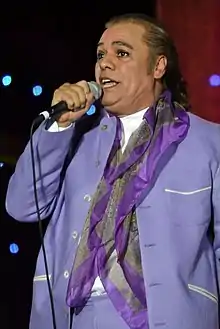 Juan Gabriel in 2012 | |
| Born | Alberto Aguilera Valadez 7 January 1950 Parácuaro, Michoacan, Mexico |
| Died | 28 August 2016 (aged 66) Santa Monica, California, United States |
| Other names |
|
| Occupations |
|
| Musical career | |
| Origin | Ciudad Juárez, Chihuahua, Mexico |
| Genres | |
| Years active | 1971–2016 |
| Labels | |
| Website | juangabriel |
| Signature | |
 | |
Having sold an estimated of 40 million records worldwide, Juan Gabriel is among Latin America's best selling music artists.[7] His nineteenth studio album, Recuerdos, Vol. II, is reportedly the best-selling album of all time in Mexico, with over eight million copies sold.[8] During his career, Juan Gabriel wrote around 1,800 songs.[5]
Among his most recognized penned songs are "Amor eterno", "Querida", "Yo no nací para amar", "Hasta que te conocí", "El Noa Noa", "No tengo dinero", "Abrázame muy fuerte", "Te lo pido por favor", "En esta primavera", "Pero qué necesidad", "Te sigo amando", "Siempre en mi mente", "De mí enamórate", and "Lo pasado, pasado", among others; all of them, performed by him and many other artists.[9]
Early life
Alberto Aguilera Valadez was born on 7 January 1950, in Parácuaro, Michoacán, Mexico. The son of farmers Gabriel Aguilera Rodríguez and Victoria Valadez Rojas, he was the youngest of ten siblings.[10] During his childhood, his father was interned into a psychiatric hospital.[11] Because of this, his mother moved to Ciudad Juárez, Chihuahua, and he was put in the El Tribunal boarding school where he remained for eight years. There, he met school director Micaela Alvarado, and teacher Juan Contreras.[10] Aguilera became very close with Contreras, then escaped El Tribunal and lived with him for a year when he was 13.[11] In the same year, Aguilera composed his first song.[12] At 14 Aguilera returned to live with his mother in the center of the town.[11] He became interested in a local Methodist Church and met the sisters Leonor and Beatriz Berúmen, who took him in.[10] There he sang in the choir and helped by cleaning the church.[11]
In 1965, Aguilera debuted on the Notivisa (now Gala TV Ciudad Juárez) television show Noches Rancheras.[10][11] Host Raúl Loya gave him the pseudonym Adán Luna. In the program, he sang the song "María la Bandida" by José Alfredo Jiménez.[10][11] From 1966 to 1968, he started to work as a singer at the Noa-Noa bar.[10][11] During this period, he wrote the song "El Noa Noa".[10] He also worked as a singer in other bars in the town.[11] Later, he traveled to Mexico City looking for opportunities at record companies, but he was rejected.[10][11] He returned to Juárez, where he continued working as a singer.[11] The next year, he tried again to be signed by a record label. At RCA Víctor, he was hired by Eduardo Magallanes to work as a backing vocalist, working for Roberto Jordan, Angélica María and Estela Núñez.[11] In 1970, he resigned because he received insufficient payment and returned to work the bars in Juárez.[11]
As people told him he would have success if he tried again, he returned to Mexico City a third time the next year. Not having enough money, Aguilera slept in bus and train stations.[11] At a certain point, he was wrongly accused of robbery,[13] and was imprisoned in the Palacio de Lecumberri prison for a year and a half.[10] During this time, he wrote songs (including "Tres Claveles y Un Rosal" and "Me He Quedado Solo"), which helped him to meet Andrés Puentes Vargas,[10] Lecumberri's prison warden, who introduced him to Mexican singer and actress La Prieta Linda.[11] and to his wife Ofelia Urtuzuastegui Ruiz. She helped him, and due to the lack of evidence he was released from prison [11] and lived in the Puentes Urtuzuastegui home for about 2 years where he found shelter, protection and support to write more songs and launch his profesional career as Juan Gabriel.
Career
La Prieta Linda helped Aguilera at RCA Víctor, where he signed a recording contract.[14] He started to use the pseudonym Juan Gabriel (Juan, in honor of Juan Contreras; and Gabriel, in honor of his own father).[11][15] In 1971, Juan Gabriel released his first studio album El Alma Joven..., which included the song "No Tengo Dinero", which became his debut single and his first hit.[16][17] El Alma Joven... was certified as gold by the Asociación Mexicana de Productores de Fonogramas y Videogramas (AMPROFON).[16] In 1972, Juan Gabriel participated at the OTI Festival, where he sang the songs "Será Mañana" and "Uno, Dos y Tres (Y Me Dás un Beso)". The songs were not qualified to represent Mexico, but they were acclaimed, and later recorded for his second album El Alma Joven II.[18] After releasing El Alma Joven III (1973), Juan Gabriel released his first mariachi album featuring the group Vargas de Tecalitlán.[11][18] The album, titled Juan Gabriel con el Mariachi Vargas de Tecalitlán (1974), includes songs like "Se Me Olvidó Otra Vez" and "Lágrimas y Lluvia".[18] In 1975, he made his acting debut in the film Nobleza ranchera, acting with Sara García and Verónica Castro.[18][19]
Over fifteen years, Juan Gabriel's fame grew as he recorded 15 albums and sold 20 million records. He wrote and recorded over 1000 songs in a variety of music genre.[2] Juan Gabriel established himself as Mexico's leading commercial singer-songwriter, penning in many diverse styles such as rancheras with mariachi, ballads, pop, rock, disco, with an incredible string of hits for himself and for leading Latin singers including among many others Lucha Villa, Daniela Romo and Ana Gabriel and international stars Luis Miguel, Rocío Dúrcal and José José who in 1978 achieved international recognition thanks to Aguilera's ballad "Lo Pasado, Pasado".[20] His lyrics dealt with heartbreak and romantic relationships that became hymns throughout Latin America, Spain, and the United States.[4] In 1984, his song "Querida" (Darling) remained at number one for the entire year on the Mexican charts. He also received a Grammy nomination for "Best Latin Pop Album" for Recuerdos, Vol. II, which includes the single.
.jpg.webp)
His work as an arranger, producer and songwriter throughout the subsequent decades brought him into contact with the leading Latin artists of the day, including Rocío Dúrcal and Isabel Pantoja. In addition to recording numerous hits on his own, Juan Gabriel has produced albums for Dúrcal, Lucha Villa, Lola Beltrán and Paul Anka.[20][21] In 1984, he released Recuerdos, Vol. II which one source says is the best-selling album of all time in Mexico with sales of over eight million copies.[22] In 1990 Juan Gabriel became the first non-classical act to perform at the Palacio de Bellas Artes.[23] The proceeds from the three sold-out concerts were given to the National Symphony Orchestra.[23] On 31 July 2000, a telenovela titled Abrázame Muy Fuerte began broadcasting in Mexico. Salvador Mejía, the producer, choose to use the song of the same name as its main theme.[24] "Abrázame Muy Fuerte" ended 2001 as the most successful Latin single of the year.[25] For the song, Juan Gabriel won two Billboard Latin Music Awards in 2002 for Hot Latin Track of the Year and Latin Pop Airplay Track of the Year; and also received the Songwriter of the Year award.[26] The song ranked seventh at the Hot Latin Songs 25th Anniversary chart.[26] "Abrázame Muy Fuerte" also was awarded for Pop Song of the Year at the 2002 Lo Nuestro Awards.[27] At the time of his death, Juan Gabriel was touring the United States and was scheduled to perform at a concert in El Paso, Texas, that same day.[28] He also had four albums which reached number one on the Top Latin Albums from 2015 and 2016, including Vestido de Etiqueta por Eduardo Magallanes, which reached number one a week before he died. He holds the record for most albums peaking at number one on the Top Latin Albums chart in a short period time.[29]
In addition, he had 31 songs that charted on the Hot Latin Songs chart, seven of which reached number one.[30]
BMG copyright dispute
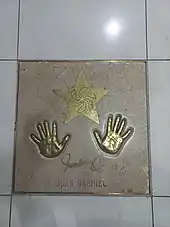
Between 1986 and 1994, Juan Gabriel refused to record any material because of a dispute with BMG over copyrights to his songs. He continued his career in live stage performances, setting attendance records throughout Latin America. By 1994 the copyright dispute reached a resolution under an agreement whereby ownership of the songs reverted to Juan Gabriel over a specified time period.[15] After this dispute, which lasted 8 years, he released an album titled, "Gracias Por Esperar," which in English, translates to, "Thank You For Waiting". The record label then selected eleven previously released tracks from Juan Gabriel's catalog in order to release "Debo Hacerlo", the last new song recorded by the artist.[20]
Personal life
Juan Gabriel was never married. He had six children. The mother of four of his children (Iván Gabriel, Joan Gabriel, Hans Gabriel and Jean Gabriel) is Laura Salas. Gabriel stated that Salas was "the best friend of my life" ("la mejor amiga de mi vida" in Spanish).[31] Nearly a month after his death, the news program Primer Impacto discovered that Gabriel had a fifth child, a son named Luis Alberto Aguilera, living in Las Vegas. The two maintained a long-distance relationship, primarily communicating via e-mail. The mother of his fifth child is Guadalupe Gonzalez, who worked as Gabriel's domestic employee.[32] On 26 October 2016, Primer Impacto found the sixth child of Juan Gabriel, named Joao Gabriel, living in Los Angeles, California. Joao's mother is Consuelo Rosales, who also worked as Gabriel's domestic employee.[33] Genetic testing was conducted to assess Gabriel's parentage of Luis Alberto and Joao, with genetic material provided by Gabriel's brother Pablo Aguilera.[34]
Although widely assumed to be gay, Gabriel never explicitly talked about his sexuality.[35][36] However, as he got older he began to give implicit responses towards questions about his sexuality, saying to interviewers "Lo que se ve no se pregunta" ("what one sees doesn't have to be asked about").[37] Some may interpret this to be an implicit affirmation of homosexuality,[38] while others have interpreted this to be an affirmation of heterosexuality, due to the female romantic partners he had.[39] On 14 November 2005, Gabriel was injured when he fell from the stage at the Toyota Center in Houston, Texas, and was hospitalized at Texas Medical Center.[40][41] He sustained a fractured neck. He was forced to stay off tour and bedridden for eight months.
Political views
Juan Gabriel was a lifelong supporter of the Institutional Revolutionary Party (PRI), which governed Mexico from 1929 to 2000 and again from 2012 to 2018. In 1994 he stated that "his best friends [were] from the PRI" and campaigned in support of then-presidential PRI candidate Ernesto Zedillo.[42] In the 2000 election he again campaigned for the PRI candidate, Francisco Labastida (who eventually lost the election). In 2015, he wrote a letter to the then-President of Mexico Enrique Peña Nieto (a member of the PRI), expressing his support for his administration and for the PRI, which he stated, "will never go away".[43][44]
Death

On 28 August 2016, Juan Gabriel died in Santa Monica, California, reportedly from a heart attack.[45] Gabriel's body was cremated; his ashes were returned to a house he owned in Ciudad Juárez, Chihuahua, after receiving tributes from the city and Palacio de Bellas Artes in Mexico City. An autopsy was not performed to determine the cause of death.[46][47]
Charity work
Juan Gabriel continued to do 10 to 12 performances per year as benefit concerts for his favorite children's homes, usually posing for pictures with his fans and forwarding the proceeds from the photo ops to support Mexican orphans.[15] In 1987, he founded Semjase,[48] a house for orphaned and underserved children located in Ciudad Juárez, Chihuahua. It serves school children between the ages of 6 and 12.[2]
Legacy and impact
In 2015, Billboard listed Juan Gabriel among their list of the 30 most influential Latino artists in history, citing his "dramatic performance style" and his redefined concept of romantic Latin pop music. The publication noted Gabriel's appeal among several generations of Latino Americans and artists.[49] In his list of the most influential Latin music artists in history, Carlos Quintana of About.com, ranked Juan Gabriel number six for shaping "the sounds of Mexican music" and exploring genres from ranchera to Latin pop.[50] In 1986, Los Angeles Mayor Tom Bradley declared 5 October Juan Gabriel day.[2] He received the Lo Nuestro Excellence Award in 1991.[51] In 1996, he was inducted into the Billboard Latin Music Hall of Fame,[2][20] while in 2003 he was inducted into the International Latin Music Hall of Fame,[52] and posthumously inducted into the Latin Songwriters Hall of Fame in October 2016.[53] In 2023, Rolling Stone ranked Juan Gabriel at number 172 on its list of the 200 Greatest Singers of All Time.[54]
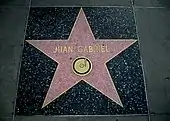
The American Society of Composers, Authors and Publishers (ASCAP) honored Juan Gabriel the Latin Songwriter of the Year Award in 1995, 1996, and 1998.[55][56][57] In 1999, Gabriel received the People's Choice Awards for Best Regional Artist.[15] That same year, he received the La Opinión Tributo Nacional for Lifetime Achievement Award.[15] A statue was erected by Billboard at Mexico City's Plaza Garibaldi in 2001, and remains a popular destination for mariachi performances.[15] In 2009, the singer was honored as the Latin Recording Academy's Person of the Year.[58] He also received his own star on the Hollywood Walk of Fame in May 2002.[59]
His death became a worldwide trending topic on Twitter after news reports were confirmed.[28] President of Mexico Enrique Peña Nieto, called him one of Mexico's "greatest musical icons".[5] United States President Barack Obama also commented on Juan Gabriel's death and complimented his music for "transcending borders and generations" and that "his spirit will live on in his enduring songs, and in the hearts of the fans who love him".[60] Gabriel Abaroa, the CEO of the Latin Recording Academy, said his legacy was "much more than one or hundreds of songs; he composed philosophy" and that Juan Gabriel "broke taboos, devoured stages and conquered diverse audiences".[61] Leila Cobo of Billboard proclaimed Juan Gabriel as a "prodigal performer" and noted that his songs were "romantic, colloquial, emotional compositions that sometimes rambled but managed to strike a universal chord with lyrics that could apply to many people and many situations."[62]
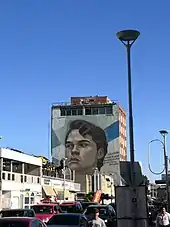
Gabriel's songs have been covered by artists such as Rocío Dúrcal, Gloria Trevi, La India, and Marc Anthony, the latter of whom credits his song "Hasta Que Te Conocí" as the inspiration to launch his career in Latin music.[62] Tribute albums to Gabriel have been recorded by several artists including Cristian Castro, Pedro Fernández,[63] Lorenzo Antonio,[64] Álvaro Torres,[65] Los Tri-O,[66] Nydia Rojas,[67] and La India.[68] A television series based on Gabriel's life titled Hasta que te conocí, began airing on 18 April 2016, and the series ended on 28 August, coincidentally the same day Gabriel died.[69] He was portrayed by Colombian actor Julián Román and Juan Gabriel served as the executive producer.[70]
Selected films and television shows
- 1965: Noches Rancheras[10]
- 1975: Nobleza ranchera[19]
- 1976: En esta primavera[19]
- 1978: Del otro lado del puente[19]
- 1979: El Noa Noa[19]
- 1980: Es mi vida[19]
- 2013: ¿Qué Le Dijiste A Dios?
- 2016: Hasta que te conocí
Discography
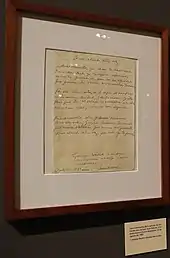

- 1971: El Alma Joven...
- 1972: El Alma Joven Vol.II
- 1973: El Alma Joven Vol.III
- 1974: Juan Gabriel con el Mariachi Vargas de Tecalitlán
- 1975: 10 Éxitos de Juan Gabriel
- 1976: A Mi Guitarra
- 1976: Juan Gabriel con Mariachi Vol. II
- 1977: Te Llegará Mi Olvido
- 1978: Siempre en Mi Mente
- 1978: Espectacular
- 1978: Mis Ojos Tristes
- 1979: Me Gusta Bailar Contigo
- 1980: Recuerdos
- 1980: Juan Gabriel Con Mariachi
- 1980: Ella
- 1981: Con Tu Amor
- 1982: Cosas de Enamorados
- 1983: Todo
- 1984: Recuerdos, Vol. II
- 1986: Pensamientos
- 1988: Debo Hacerlo
- 1990: Juan Gabriel en el Palacio de Bellas Artes
- 1994: Gracias por Esperar
- 1995: El México Que Se Nos Fue
- 1996: Las Tres Señoras (Beltran/Mendoza/Villa) – Temas y Produccion de Juan Gabriel
- 1997: Juntos Otra Vez with Rocío Dúrcal
- 1998: Con la Banda...El Recodo with Banda El Recodo
- 1999: Todo Está Bien
- 2000: Abrázame Muy Fuerte
- 2003: Inocente de Ti
- 2010: Juan Gabriel
- 2015: Los Dúo
- 2015: Los Dúo, Vol. 2
- 2016: Vestido de Etiqueta por Eduardo Magallanes
- 2022: Los Dúo, Vol. 3
- 2023: México con Escalas en Mi Corazón (Ciudades)
Concert tours
- Volver Tour (2014)[71]
- Bienvenidos al Noa Noa Gira (2015)
- Mexico Es Todo Tour (2016, died during tour)[72]
See also
References
- "Muere el cantante y compositor mexicano Juan Gabriel". Univision (in Spanish). 28 August 2016. Retrieved 28 August 2016.
- "Sears Presents Juan Gabriel's U. S. Tour". Hispanianews.com. Archived from the original on 24 September 2015. Retrieved 26 March 2015.
- Martínez-Staines, Javier; Univision Noticias: La importancia de Juanga, según los intelectuales' (In Spanish) Retrieved Present.
- Bautista, Bernice. "Juan Gabriel, Mexican superstar singer-songwriter, has died". Yahoo.com. Archived from the original on 29 August 2016. Retrieved 14 March 2022.
- "Juan Gabriel, The 'Divo Of Juarez,' Dies At 66". NPR.org. Retrieved 28 August 2016.
- "The 30 Most Influential Latin Artists of All Time". billboard.com. 28 April 2015. Retrieved 20 March 2018.
- "Las cifras millonarias de Juan Gabriel". Semana (in Mexican Spanish). 29 August 2016. Retrieved 2 March 2023.
- González, Ángel (19 December 2009). "Cine y música: en México y el mundo" [Movies and music: In Mexico and the world]. Diario Rotativo (in Spanish). Archived from the original on 14 March 2012. Retrieved 28 August 2016.
- Alfaro, Ramón. "Los artistas que interpretaron las canciones de Juan Gabriel". El Universal. Retrieved 29 August 2016.
- "Perfil. Adiós a Juan Gabriel, El Divo de Juárez". El Universal (in Spanish). 28 August 2016. Archived from the original on 29 August 2016. Retrieved 28 August 2016.
- "Biografía de Juan Gabriel" (in Spanish). Sociedad de Autores y Compositores de México. Archived from the original on 30 July 2016. Retrieved 28 August 2016.
- "Mexican superstar Juan Gabriel supposedly dies at 66 of heart attack". BBC News. 29 August 2016. Retrieved 29 August 2016.
- Nájar, Alberto (29 August 2016). "Muere el cantante mexicano Juan Gabriel, "El Divo de Juárez"" (in Spanish). Mexico City: BBC Mundo. Retrieved 29 August 2016.
- "Cd. Juárez, la tierra adoptiva y los inicios de Juan Gabriel". Revista Quién (in Spanish). Expansión, S.A. de C.V. 15 April 2014. Archived from the original on 8 August 2016. Retrieved 28 August 2016.
- "Gabriel, Juan Biography". eNotes. Archived from the original on 15 November 2006. Retrieved 28 August 2016.
- "Juan Gabriel, el divo que México y América lloran". La Prensa (in Spanish). 28 August 2016. Archived from the original on 30 August 2016. Retrieved 28 August 2016.
- ""No tengo dinero", primer éxito de JuanGa" (in Spanish). Tiempo. 28 August 2016. Archived from the original on 30 August 2016. Retrieved 28 August 2016.
- Morales Valentín, Emilio (22 November 1999). "Juan Gabriel compuso "No Tengo Dinero" en Venezuela". El Universal (in Spanish). Archived from the original on 11 September 2016. Retrieved 29 August 2016.
- "In Memoriam: Juan Gabriel, the Actor". Cinema Tropical. 28 August 2016. Archived from the original on 7 September 2016. Retrieved 29 August 2016.
- Craig Harris (7 January 1950). "Juan Gabriel | Biography". AllMusic. Retrieved 26 March 2015.
- "Yahoo Shopping – Online Shopping with great products, prices and reviews". Shopping.yahoo.com. Archived from the original on 23 February 2005. Retrieved 26 March 2015.
- González, Ángel (19 December 2009). "Cine y música: en México y el mundo". Diario Rotativo (in Spanish). Archived from the original on 14 March 2012. Retrieved 9 November 2013.
- "Juan Gabriel, Mexican Superstar Singer-Songwriter, Dies at 66". The New York Times. Retrieved 28 August 2016.
- "Abrázame Muy Fuerte". Telemetro. Corporación Medcom Panamá, S.A. Archived from the original on 24 December 2009. Retrieved 25 August 2010.
- "The Year in Music 2001: Hot Latin Tracks". Billboard. Vol. 113, no. 52. Nielsen Business Media, Inc. 29 December 2001. p. YE-59. Retrieved 10 March 2010.
- Trust, Gary (4 October 2011). "Hot Latin Songs Top 25 – The Biggest Hits of the Last 25 Years". Billboard. Macromedia Corporation. Retrieved 4 October 2011.
- "Premios Lo Nuestro a la Musica Latina: Lo que fue Lo Nuestro en 2002". Univision. Univision Communications Inc. 2002. Archived from the original on 13 October 2013. Retrieved 14 August 2013.
- Moreno, Carolina. "Juan Gabriel, Mexican Singer And Icon, Dead At 66". Huffington Post. Retrieved 28 August 2016.
- Cuevas, Mayra (29 August 2016). "Juan Gabriel dead at 66; he was Mexican music icon". CNN. Retrieved 29 August 2016.
- Flores, Griselda; Mendizabal, Amaya (28 August 2016). "Juan Gabriel Dies at 66: His Biggest Albums, Songs & Tours". Billboard. Prometheus Global Media. Retrieved 29 August 2016.
- Acosta, Dave. "Juan Gabriel, Mexican superstar singer, dead at 66". Usatoday.com. El Paso Times. Retrieved 29 August 2016.
- Valdez, Maria G. (26 September 2016). "Juan Gabriel's secret son". Latin Times. Retrieved 2 October 2016.
- "Te presentamos a Joao Gabriel Alberto Aguilera, el nuevo hijo secreto de Juan Gabriel". Univision. Primer Impacto. 26 October 2016. Retrieved 5 January 2017.
- "Joao Gabriel Aguilera es hijo de Juan Gabriel al 99.9%, según la prueba de ADN". www.univision.com. Retrieved 31 January 2017.
- "Juan Gabriel was Mexico's gay icon — but he never spoke of his sexuality". Los Angeles Times. Retrieved 29 August 2016.
- "Juan Gabriel Died One Year Ago: LGBTQ Latino Writers Reflect On His Impact". NBC News. 28 August 2017. Retrieved 28 August 2017.
- "'Gracias Juanga': On anniversary of his death, LGBTQ Latino writers reflect on Juan Gabriel's impact". NBC News. 28 August 2017. Retrieved 16 August 2021.
- "Así salieron del armario las estrellas gais de la música". abc (in Spanish). 21 June 2020. Retrieved 22 September 2022.
- de 2020, 29 de Junio. ""Lo que se ve no se pregunta": cómo surgió la famosa frase de Juan Gabriel". infobae (in European Spanish). Retrieved 22 September 2022.
- "Chicago News, Local News, Weather, Traffic, Entertainment, Video, and Breaking News". Nbc5.com. Archived from the original on 29 June 2008. Retrieved 26 March 2015.
- Archived 24 August 2007 at the Wayback Machine
- "El Juan Gabriel del PRI". Proceso. Retrieved 25 August 2020.
- "Juan Gabriel escribió una carta a Peña Nieto alabando al PRI". Excelsior. 30 August 2016. Retrieved 25 August 2020.
- "Revelan contenido de la carta que Juan Gabriel dejó a Peña Nieto". Quien-com. 31 August 2016. Retrieved 25 August 2020.
- "Muere el cantante y compositor mexicano Juan Gabriel". Univision Communications Inc. Univision. 28 August 2016. Retrieved 28 August 2016.
- EFE (30 August 2016). "Juan Gabriel cremated, family tells Mexican officials". FOX News Network, LLC Latino. FOX. Archived from the original on 1 September 2016. Retrieved 31 August 2016.
- Figueroa, Lorena (2 September 2016). "Juárez to be Juan Gabriel's final resting place". El Paso Times. Gannett. Retrieved 7 September 2016.
- Archived 19 February 2007 at the Wayback Machine
- "The 30 Most Influential Latin Artists of All Time". Billboard. Prometheus Global Media. 12 November 2015. Retrieved 29 August 2016.
- Quintana, Carlos. "Latin Music Legends". About.com. Archived from the original on 11 September 2016. Retrieved 29 August 2016.
- Lannert, John (1 June 1991). "Latin Music Finds Harmony In Awards Crisp, Entertaining Tv Program A Breakthrough For Fledgling Trade Group". Sun-Sentinel. Retrieved 16 August 2013.
- "International Latin Music Hall of Fame announces inductees for 2003". 3 March 2003. Retrieved 31 October 2015.
- "2016 Inductees & Honorees". Latin Songwriters Hall of Fame. 13 October 2016. Retrieved 4 November 2016.
- "The 200 Greatest Singers of All Time". Rolling Stone. 1 January 2023. Retrieved 22 February 2023.
- "The Third Annual El Premio ASCAP". Billboard. Vol. 107, no. 38. Prometheus Global Media. 23 September 1995. p. 16. Retrieved 27 September 2013.
- "ASCAP Congratulates the Winners of the fourth El Premio ASCAP". Billboard. Vol. 108, no. 37. Prometheus Global Media. 14 September 1996. p. 17. Retrieved 27 September 2013.
- "The Sixth Annual El Premio ASCAP". Billboard. Vol. 110, no. 36. Prometheus Global Media. 5 September 1998. p. 18. Retrieved 14 June 2013.
- "Juan Gabriel is the 2009 Latin Recording Academy Person of the Year" (Press release). Latin Academy of Recording Arts & Sciences. 15 September 2009. Archived from the original on 1 February 2013. Retrieved 8 November 2010.
- "Mexicanos con estrella... en Hollywood". Milenio (in Spanish). 26 May 2016. Retrieved 30 August 2016.
- Latimer, Brian (29 August 2016). "Pres. Obama on Juan Gabriel: 'He was one of the greats'". NBC News. Retrieved 30 August 2016.
- Abaroa, Gabriel (28 August 2016). "The Latin Recording Academy® Statement re: Juan Gabriel". Latin GRAMMYs. Retrieved 29 August 2016.
- Cobo, Leila (28 August 2016). "Mexican Superstar Juan Gabriel Dies at 66". Billboard. Prometheus Global Media. Retrieved 29 August 2016.
- "Pedro Fernández – Querida". AllMusic. Rovi. Retrieved 11 September 2016.
- "Mi Tributo a Juan Gabriel – Lorenzo Antonio". AllMusic. Rovi. Retrieved 29 August 2016.
- "Interpreta A Juan Gabriel En Bolero – Alvaro Torres". AllMusic. Rovi. Retrieved 29 August 2016.
- "Siempre en Mi Mente – Los Tri-O". AllMusic. Rovi. Retrieved 29 August 2016.
- "Nydia Rojas – Nydia Rojas". AllMusic. Rovi. Retrieved 29 August 2016.
- "Intensamente con Canciones de Juan Gabriel – India Rojas". AllMusic. Rovi. Retrieved 29 August 2016.
- "¿Triste coincidencia? Hoy finaliza "Hasta que te conocí", la serie de Juan Gabriel". SDPNOTICIAS.COM (in European Spanish). 29 August 2016. Retrieved 29 August 2016.
- Hansen, Lena (28 August 2016). "Julián Román habla sobre interpretar a Juan Gabriel en la serie Hasta que te conocí de Telemundo". People en Español (in Spanish). Retrieved 29 August 2016.
- "Juan Gabriel's Volver Tour 2014 – Miami". Miami New Times. 8 September 2014. Archived from the original on 13 October 2016. Retrieved 29 August 2016.
- "Juan Gabriel announces 'Mexico es Todo' tour". El Universal. 27 May 2016. Archived from the original on 19 July 2016. Retrieved 29 August 2016.